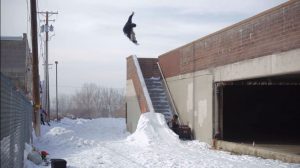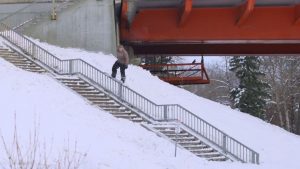In 2015, Nike Snowboarding had cultivated what at the time was considered one of the best collections of talent that the snowboard industry has seen in its short lifespan. Everyone in the industry knew what this team was capable on snow in terms of progression, but Nike wanted to celebrate the riders behind that progression, what inspired them, what made them tick, and ultimately allow us viewers to get closer to the riders who year in and year out pushed themselves and the sport for the entertainment of others. It was that kind of thinking that sparked the Never Not project. The project was groundbreaking in the sense that Nike decided to put out two separate videos in the same year, which had never been done before. One project continuing the industry standard of trick based videos (Never Not Part 1), and the second project taking a more documentary based approach (Never Not Part 2). Never Not Part 2, being more of a traditional documentary, consisted of interviews with the riders throughout their time filming for their part in Never Not Part 1, and gave a behind the scenes look of what these peoples lives are like outside of the two and a half minute part they produce each year. The first thing that really stood out to me while watching this short film was how well the director, Per-Hampus Stalhandske, made a concerted effort to blend “traditional” snowboard videography with more cinematic scenes. To accomplish this he incorporated techniques such as matched action sequences,use of motion graphics/effects, as well as well thought out B-roll and scene composition. Taking this more cinematic approach reinforced that this was not another snowboard video. This is a fairly long piece clocking in at around an hour, and for the sake of brevity I am going to focus on my favorite part, Act 1: Adaptation due to its easy to follow story arc and seamless transition between the styles mentioned above.
Act 1: Adaptation:
Act one starts with numerous beautiful establishing shots of cityscapes, streets, construction workers, and general urban sprawl. When people think of snowboarding they think of the mountains and ski resorts, not frozen cities. The use of these establishing shots set the tone for the theme (and title) of this act right from the beginning as this is all about “urban snowboarding, and the snowboarders who have adapted their craft to the environment around them. In this jump-cut sequence there are text book examples of cutting on the beat using natural sounds (04:38-04:44), rack zooms (04:45), and world building. This extended jump-cut sequence starts to build the urban world that these snowboarders thrive in, and have adapted to. As the sequence goes on, these characters are then introduced to the world that has been built, and we see all the work they put into their craft, scouting locations, shoveling snow, and pulling bungees, all in preparation to film a trick.
This sequence then transitions smoothly into a short snowboarding montage where we start to see the end product of what the jump-cut sequence established. This section is all shot and edited in the way a “traditional” snowboard video would be shot using techniques such as follow cam with a fisheye lens (05:21-05:30), time remapped (or ramped) clips (05:40), and excellent use of music, whether it was timed up for a rider to land on a certain beat or a cut on a beat.
The sequence then transitions back into the documentary style, with the end of the music and another jump-cut sequence of wide establishing shot and some more cut away of urban scenes, while also bringing in the voice over of one of the riders. This is what I absolutely love about this film. The way that Per-Hampus is able to seamlessly transition between different styles while still continuing to move the story along and not take the viewer out of a particular scene is something I wish to incorporate into my future work. After the film has re-established the tone from that of action sports movie to that of a “documentary” we get the first interviews. I enjoy how Per-Hampus used both actual interview footage as well as using the audio from the interviews as voice overs when called for. For example Jed Anderson was speaking of how skateboarders and snowboarders are always seeing things differently and how he is always looking for spots (06:18-06:45) . This piece of the interview was made more effective by the use of voice over with accompanying shots of architecture, rails, and snowboarders actively looking for spots, as it really takes us into the eyes and mind of Jed. I did find it interesting that that for the sit down interviews it seemed as if it was a single camera set up, punched in pretty far, and that the camera was not locked down onto a tripod. I wonder if that was more out of necessity do to room limitations, as these interviews were all captured while traveling for this project, or a purposeful stylistic choice by Per-Hampus.
After some more interview footage comes one of my favorite sequences in the whole video, a textbook jump-cut sequence that depicts all the behind the scenes details that go into getting one shot (08:40-09:10). Outside of the snowboard world, very little is known about how much work goes into the process of filming a video part as everyone just sees the finished product, and this little gem of a scene does a fantastic job of showing all the work it takes to get a shot before the actual snowboarding begins. The way it offers insight into a rarely seen process really adds to the theme of adaptation this act is all about. From this point on it is more of the same, interview footage, mixed in with voice overs when applicable which leads toward an emotional sequence of the mental and physical toll this process has on the riders. In a very emotionally charged sequence Per-Hampus uses music to great effect as we see riders struggling both mentally and physically, cutting on beats to add extra drama to some brutal falls, all while using a song that conveys a frantic yet moody tone that only serves to highlight the struggles of the riders. He also uses quick cuts to great effect once again setting that frenetic, uncomfortable tone to really highlight what the riders are going through (10:50-12:30).
After we go through the emotional lows along with the riders we are then picked back up again with the riders speaking about how all of that toil and struggle is worth it at the end of the day. They speak of how the joy and sense of accomplishment that they feel once they get their shot outweighs all the struggle, and is what inspires them to progress each year. We get to ride an emotional high with them as the part wraps up. Per-Hampus once again transitions back toward a “traditional” snowboard action sequence, utilizing fisheye lens’s, time remapping, matched action sequences, and jump-cuts, as we truly see the end product from these riders (13:30-15:50). This sequence brilliantly brings the story arc to a close and ends the piece on a high note as it transitions on in to the next act in the project.
Overall this section (Act 1: Adaptation) of the whole project could stand alone as a short (as could each part in the whole video). Act 1: Adaptation is a testament to what can happen when a director who has a background in two different film making approaches is given the creative freedom to tell an intriguing story while blending both of his styles into a cohesive piece. This type of work has enough of the raw, run and gun style of a traditional snowboard video to appeal to the more “core” viewer, while also having a style and approach to appeal to a more casual viewer who does not know much about snowboarding and is wanting to learn more about it. As someone who comes from the “core” side of things and has experience shooting in the more raw run and gun style of a traditional action based sequences it is pieces like these that inspire me to break away from my “tried and true” methods of shooting and editing, and learn new ways to tell a story so that I too can be able to blend styles seamlessly into a project like this.














Leave a Reply